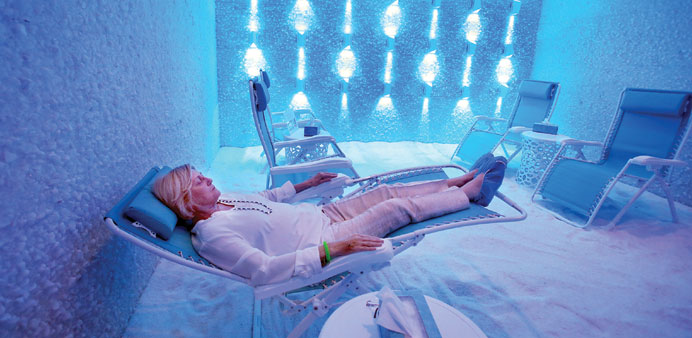Docs sceptical, but salt-therapy fans say treatment
helps breathing, other ills. By Susan Jacobson
Dianne Duvall lay in a recliner, the room awash in dim blue light, and took breath after breath of salty air.
Around her, the walls were lined with of chunks of salt. Beneath her, the floor was covered with salt pebbles.
Duvall is a customer at a new kind of spa that proponents say relieves ailments from emphysema to psoriasis. It’s called halotherapy, or salt therapy.
“Very peaceful, very serene, and you can feel it’s drying you up so that you cannot have a runny nose,” said Duvall, a real-estate agent who suffers from allergies.
While many customers such as Duvall swear by salt therapy, the medical community is not sold on it.
Dr Norman Edelman, senior scientific adviser to the American Lung Association, said the salt particles in therapy rooms are too big to be inhaled deeply into the lungs, but breathing them does loosen mucus and promote coughing, which may make some patients feel better.
He said he doesn’t recommend the therapy or think it helps a lot of people. Nor is it regulated or covered by health insurance in the US. A single 45-minute session is $49 for an adult at The Salt Scene, where Duvall goes, and $45 at The Salt Room, although both offer packages and memberships.
“In anything we do in medicine, there is always a huge placebo effect, especially in asthma,” said Edelman, a professor at Stony Brook School of Medicine who specialises in internal and pulmonary medicine.
There are three salt spas in the Orlando area. The newest is The Salt Scene, which opened in July. Owner Rupal Thakkar began taking her then-toddler daughter to The Salt Room in Orlando about four years ago. Her paediatrician was sceptical, but Thakkar was so impressed with the improvement in her daughter’s eczema that she decided to open her own salt-therapy business closer to home.
“Instead of having her on meds for a lifetime, I’m able to control her symptoms,” said Thakkar, a dentist who maintains a dental practice in the same shopping center as The Salt Scene.
The healing power of salt was touted centuries ago in Greece and at the Dead Sea. The modern salt spa became possible when a machine to crush and disperse salt particles was invented in 1985 in Russia, where doctors used it to treat respiratory conditions, said Ulle Pukk, co-founder of the Salt Therapy Association in Boca Raton.
In the US, one of the first salt spas was built in the Chicago suburb of Skokie in 2006, owner Isabella Samovsky said. The US has more than 125 salt-therapy businesses, according to the Salt Therapy Association. Salt rooms also can be found in Eastern Europe, Israel, Canada and Australia and on two Norwegian Cruise Lines ships, including the Getaway, which began sailing out of Miami last year.
The salt-therapy experience is meant to mimic the environment of salt caves, only with considerably more modern spa amenities and a New Age vibe. During a salt-room session, a client reclines, feet elevated, in a “zero-gravity” chair designed to reduce stress on the spine and impart a sense of weightlessness.
A generator pulverises pharmaceutical-grade salt, blowing tiny particles into the room, said Ashley Steiner, a former third-grade teacher who owns The Salt Room, which is celebrating its fifth anniversary. Some people read, meditate or doze, while others listen to soothing music. Many prefer subdued lighting. “Salt is antibacterial and antimicrobial, and it helps open the airways and reduce any congestion,” said Steiner, who is on the board of the Salt Therapy Association.
Although scant studies have examined the practice, the New England Journal of Medicine in 2006 concluded that inhaling saline can improve lung function in people with cystic fibrosis. Retired speech pathologist Nancy Stone has gone to The Salt Room for several years to get relief from her cystic fibrosis. “I can take deeper breaths, and it helps me cough,” Stone said. “It’s such an uplifting place, and the people here are so positive.”
Kristine Osborne said her four-year-old daughter, Stella, had recurrent ear infections before she started going to The Salt Room about a year ago. On a recent day Stella cooked pretend chicken soup on a play stove, coloured and dug in the salt in the children’s room.
“It worked beautifully,” Osborne said. “To have your child not be sick, you can’t put a dollar value on that.”
Dr Neil Kao, an internist, allergist and immunologist who teaches at the University of South Carolina, said he’s unaware of any benefit — or harm — from salt rooms, although he said he’s not sure why soaking in an Epsom-salt bath or relaxing at the beach wouldn’t have a similar effect at a much lower cost.
“Even if you’re going in there pessimistically, sitting in a comfortable chair in a very quiet room is probably very calming,” Kao said. — Orlando Sentinel/TNS

